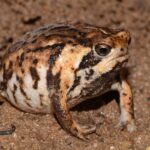- Ansonia echinata: Exploring the Fascinating Spiny Slender Toad of Borneo
- Introduction: A Unique Amphibian from Borneo's Hidden Streams
- Taxonomy and Classification
- Natural Habitat: Secrets of the Streamside Understory
- Physical Characteristics: A Creature Defined by Unique Adaptations
- Behavior and Life Cycle: Quiet Lives Amidst Gentle Streams
- Ecological Role: Guardians of a Balanced Rainforest
- Threats and Conservation Status: A Fragile Existence at Stake
- Cultural and Scientific Significance: Beyond Its Forest Boundaries
- Conclusion: Preserving Borneo's Amphibian Treasure
Ansonia echinata: Exploring the Fascinating Spiny Slender Toad of Borneo#
Introduction: A Unique Amphibian from Borneo’s Hidden Streams#
Tucked away within the dripping, verdant jungles of Borneo lies a creature that could easily have sprung from the imagination of a fantasy author. Known scientifically as Ansonia echinata, this remarkable amphibian—commonly referred to as the Spiny Slender Toad—captures attention with its unique appearance, secretive habits, and critical ecological roles. Though modest in size, the uniqueness of this elusive species contributes to the overall health and diversity of the rainforest ecosystem, making its study and conservation increasingly important.
Perhaps most strikingly, Ansonia echinata sports an appearance more akin to science fiction than reality; its rugged skin adorned with spine-like protrusions that have earned it common names referencing its bristly physique. Yet, this peculiar appearance belies its delicate vulnerability to environmental disturbances, prompting dedicated researchers and conservationists to closely monitor and protect its fragile habitat.
Taxonomy and Classification#
Belonging to the extensive family Bufonidae—a family renowned worldwide for its diversity and distinctive “toady” appearances—Ansonia echinata finds itself neatly classified among the slender toads of the genus Ansonia. This genus consists primarily of small, climbing, forest-dwelling amphibians prevalent across Southeast Asian rainforests.
First scientifically described by the renowned herpetologist Robert Inger in 1960, Ansonia echinata has intrigued scientists for decades, prompting them to continuously explore its ecology and behavior. Its closest relatives share a similar lifestyle, preferring rocky streams and humid tropical landscapes, yet none surpass the sheer uniqueness of its external morphology, which sets it distinctly apart from other members of the genus.
Natural Habitat: Secrets of the Streamside Understory#
The enchanting habitats of Ansonia echinata are deeply tied to pristine forest environments. This unique amphibian occurs predominantly in the northern part of Borneo, within Sabah and Sarawak regions of Malaysia, as well as Brunei. Here, within shady glens and tangled canopies, it makes its home alongside brisk-flowing streams, embedded within damp leaf litter, moss-laden rocks, and shaded crevices.
Ensconced among lush vegetation, Ansonia echinata thrives in microhabitats abundant in humidity and subtle shade. Clear freshwater streams, trickling through fern-covered banks and mossy slopes, provide the ideal environment for its reproduction and developmental stages. The precise balance of sunlight, moisture, and temperature in these habitats uniquely supports the delicate existence of these creatures—highlighting Borneo’s sensitivity to environmental disturbances.
As such, spotting this elusive amphibian within its natural domain demands patience, a keen eye, and a willingness to undertake humid journeys deep into untouched rainforests, evoking feelings of discovery and wonder synonymous with jungle expeditions.
Physical Characteristics: A Creature Defined by Unique Adaptations#
To behold Ansonia echinata up close is to peer into Borneo’s evolutionary wonder. Measuring scarcely two to three centimeters, this diminutive toad carries a dramatic appearance that belies its modest size. Its brown-gray to dark brown body, mottled with subtle hints of earthy reds and greens, blends seamlessly into the wet forest floor and rocky substrate of its chosen habitat.
The true hallmark of Ansonia echinata manifests spectacularly on its skin, bearing unique spinous tubercles—small, pointed spikes projecting in clusters across the back, flanks, and limbs. Though not harmful to the touch, these structures serve as effective camouflage, breaking the outline of its form among leaf litter and shadows. Scientists hypothesize that these protrusions may also provide some deterrence against smaller predators or parasites, although research remains ongoing.
Further enhancing its cryptic strategy, the toad’s limbs are slender and agile, crafted evolutionarily for navigating slippery rocks, splashing streams, and dense understory—definitive adaptations that highlight the amphibian’s intimate relationship with its complex forest ecosystem.
Behavior and Life Cycle: Quiet Lives Amidst Gentle Streams#
Feeding Habits and Predation Techniques#
Like many similarly small amphibians, Ansonia echinata sustains itself on a diet largely comprising small invertebrates, notably ants, termites, mites, and beetles. Active primarily during twilight hours, the frog emerges silently from concealment, using stealth and patient hunting tactics rather than aggressive pursuit.
Mating, Reproduction, and Tadpole Development#
During the monsoon seasons, when rain replenishes the forest streams, Ansonia echinata‘s reproductive tempo quickens. Males congregate along humid banks, gently calling potential mates with intricate yet delicate chirping sounds that harmonize subtly into the nocturnal chorus of jungle night.
After mating, females lay strands of tiny eggs carefully affixed to vegetation or rocks submerged in streams. The resultant tadpoles demonstrate fascinating adaptations, employing specialized mouthparts to graze upon algae and microscopic food sources present within their watery nursery. Remarkably, they stay in clear, swift streams where oxygenation and purity are essential for survival—a testament to their reliance upon pristine aquatic conditions.
Ecological Role: Guardians of a Balanced Rainforest#
As small predators, Ansonia echinata plays a larger environmental role than first glance might suggest. By consuming insects and small invertebrates, these frogs contribute significantly to regulating local populations of pests, indirectly supporting the health of both flora and larger fauna species inhabiting the same micro-environment.
Conversely, this slender, spinous amphibian also forms part of the prey base for larger predators, including birds, snakes, and carnivorous insects, indicating its essential position within the trophic webs sustaining forest biodiversity. Additionally, as amphibians are physiological indicators of environmental health—owing to their sensitive skin and aquatic dependencies—Ansonia echinata is considered a valuable early-warning species, allowing scientists insight into ecosystem stability and environmental hazards.
Threats and Conservation Status: A Fragile Existence at Stake#
Despite residing securely in remote regions, Ansonia echinata faces increasing threats, notably habitat loss due to deforestation activities, agricultural expansion (particularly oil palm plantations), and climate-driven ecological shifts. Even subtle alterations in rainfall patterns or forest composition may significantly impact their delicate dependency on pure freshwater and protected forest canopies.
Currently listed by the IUCN Red List as Near Threatened, ongoing research and monitoring have become vital in understanding population trends and preserving suitable habitats. Fortunately, increasing conservation awareness within regional governments and communities has prompted renewed efforts toward rainforest restoration, protected area establishment, and sustainable agricultural practices intended to preserve Borneo’s biodiversity.
Cultural and Scientific Significance: Beyond Its Forest Boundaries#
While not extensively represented in local folklore, the distinct appearance of Ansonia echinata makes it an increasingly recognizable symbol of the uniqueness of Borneo’s wildlife heritage. Researchers have found valuable ecological lessons in its biological adaptations, shedding light on evolutionary processes that shape biodiversity within isolated island habitats.
These frogs represent an important flagship species promoting conservation awareness, demonstrating to the public that even small, easily overlooked creatures warrant respect and protection. By better understanding their ecology, researchers encourage sustainable practices that benefit not only Ansonia echinata but entire ecosystems.
Conclusion: Preserving Borneo’s Amphibian Treasure#
Ansonia echinata exemplifies how even the smallest rainforest resident carries outsized ecological value. Its fascinating evolution, ecological roles, and vulnerabilities highlight why protecting their remote habitats is vital. Each individual stream, each shadowy leaf-laden bank sheltering these frogs, enriches the tapestry of biodiversity native to Borneo.
To ensure future generations can marvel at this amphibian, habitat conservation, scientific research, community involvement, and thoughtful ecological stewardship must continue. Exploring the world of Ansonia echinata reminds us that the planet’s astounding biodiversity deserves our attention and dedicated care.







